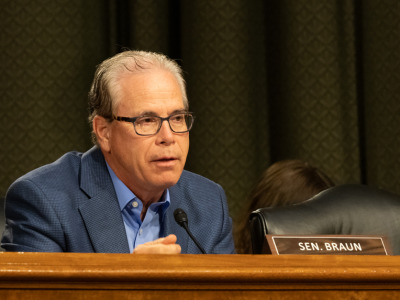Agriculture Secretary Tom Vilsack told senators Tuesday that his department is working on measures that will “significantly” increase U.S. meatpacking capacity, a top priority of producers who believe industry concentration is depressing livestock prices.
Testifying before the Senate Agriculture Appropriations Subcommittee, Vilsack also endorsed the idea of creating a new office in USDA to investigate meatpacker purchasing practices and suggested that other agribusiness sectors were ripe for reform, implying that existing patent laws were discouraging competition in the seed business.
Vilsack provided few clues as to what he would do to increase meat processing capacity but he told Sen. Jon Tester, D-Mont., USDA was looking at offering low-interest loans for new processing facilities. Vilsack still has unspent funding available from coronavirus relief packages that Congress has passed.
“We are going to come up with a very creative way to significantly expand processing capacity in this country,” Vilsack said.
After the hearing, Agri-Pulse asked Vilsack for more details about USDA’s plans, but he declined to elaborate. “More to come later,” he said.
In Vilsack’s view, increasing processing capacity would both help address producers’ pricing concerns as well as enable the industry to better shocks such as the COVID-19 pandemic or the recent ransomware attack on sector giant JBS USA.
“If you have too much concentration you may have a very efficient system but you may have … one that's not particularly resilient. I think we saw that during the pandemic,” Vilsack said.
He said the department would be making announcements in the next few weeks about funding for two small programs authorized to help small-scale processors. One would help processors qualify for federal inspection, which would, in turn, enable them to sell across state lines and into export markets. Another would reduce the overtime fees that small processors must pay for federal inspection services.
Vilsack also told the senators that in wake of the JBS hacking, USDA would be working with the food industry to ensure that companies are implementing protections against hacking.
“We're going to convene food groups to essentially make sure they understand and appreciate precisely … what is required,” he said.
Vilsack's comments came as meat processor Wholestone Farms announced a new $500 million pork processing facility in South Dakota.
Concerns about meat industry consolidation and concentration have become bipartisan and taken on new urgency in the wake of the pandemic, and more recently, the JBS case. Sen. Mike Braun, R-Ind., suggested during Tuesday’s hearing that the concerns extended to farm inputs.
“Are you concerned that within the ag community and the farming side of it that we've got issues of too much concentration within the supply side that farmers have to deal with?” Braun asked.
Vilsack responded that he thinks input costs are one reason many farmers can't support themselves on farm income, but patent protection was also contributing to the problem.

Sen. Mike Braun, R-Ind., (Photo: Joy Philippi)
“The question is whether or not it is discouraging additional competition by virtue of how much time we give (for patent protection) in this day and age of enormous, rapid change,” Vilsack said. “We ought to be taking a look at those issues, I think, to figure out ways in which we can moderate those (input cost) increases so that farmers have a chance of making more from their farm.”
Interested in more coverage and insights? Receive a free month of Agri-Pulse West
Staffing issues also surfaced as a concern during the hearing.
Vilsack insisted that the Farm Service Agency and Natural Resources Conservation Service were keeping pace with handling program demands despite some local staff continuing to work remotely. He said that 75% of FSA staff were back in agency offices and almost the same percentage of NRCS staff.
He said that USDA was working on a return-to-work plan, but field offices were limited in how many people they could bring into their facilities in part because of social distancing requirements involving workers who aren’t vaccinated against COVID-19.
“If you have to social distance, that creates an issue with reference to the size of the office (staff) itself. But I want to assure you that the work is getting done,” Vilsack told Sen. Jerry Moran, R-Kan.
Vilsack also used the hearing to press the appropriators to fund staffing increases in the department, particularly within Rural Development and NRCS.
The White House’s fiscal 2022 budget calls for 99,365 full-time equivalent staff at USDA, up from the estimated 96,072 on the payroll in FY21, which ends Sept. 30, and the 86,434 employed in FY20.
NRCS would have a staff of 11,011 in FY22, the same as in FY21 but up from 8,597 in FY20. The Rural Development staff would grow from 4,766 this year to 5,156 in FY22 under the proposed budget.
NRCS is viewed as critical to helping farmers implement climate-smart practices, a priority for the administration.
“There's a lot of work we can and should, and ought to be doing on the ground, and there are no better problem solvers I don't believe in all of government than the good folks that work at NRCS. There just aren't enough of them,” Vilsack said.
For more news, go to www.Agri-Pulse.com.


